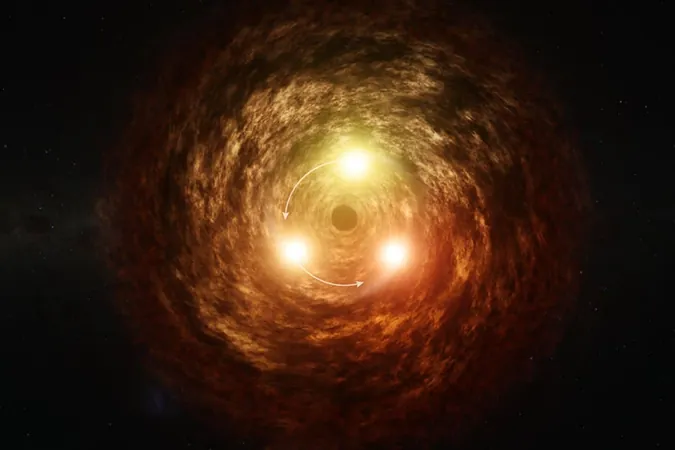
Breakthrough Discovery: Supermassive Black Hole Sagittarius A* Caught Emitting Mysterious Flare!
2025-01-22
Author: Michael
Astronomers have made a groundbreaking advancement in the study of Sagittarius A*, the supermassive black hole located at the heart of our Milky Way galaxy. Though typically known for its relative tranquility compared to other more active black holes, Sagittarius A* has once again astounded researchers.
On April 6, 2024, scientists utilizing the James Webb Space Telescope (JWST) recorded an unprecedented event: a mid-infrared flare. This historic observation represents a significant leap in our understanding of black holes, providing critical insights into their behavior and the underlying physics that governs their activity.
Witnessing a Cosmic Phenomenon
Sagittarius A* is astonishingly massive—about 4.3 million times the mass of our Sun—and is the closest supermassive black hole to Earth. While it generally exhibits a quieter demeanor, it has been known to unleash energetic outbursts or what scientists refer to as “burps.” The recent observation recorded a mid-infrared flare that lasted approximately 40 minutes, marking a crucial milestone in astrophysical research.
Previously, astronomers had focused primarily on radio and near-infrared observations. However, mid-infrared data had been scarce, leaving many questions unanswered about Sagittarius A*’s behavior. Joseph Michail from the Smithsonian Astrophysical Observatory stated, “For over 20 years, we’ve observed activity in the radio and near-infrared ranges, but the connection between them remained elusive. This new mid-infrared observation helps bridge that gap.”
Unraveling the Secrets of the Flare
This monumental observation was achieved by integrating data from an array of sophisticated instruments. In addition to JWST’s mid-infrared instrument (MIRI), the research team employed the Submillimeter Array, NASA’s Chandra X-ray Observatory, and the Nuclear Spectroscopic Telescope Array on the International Space Station. Interestingly, while X-rays and gamma rays were not detected, the Submillimeter Array did catch a radio wave flare that occurred 10 minutes after the mid-infrared flare, supporting models of synchrotron radiation where electrons accelerate along magnetic fields, losing energy as they cool.
“This mid-infrared data unveils critical insights into how electrons interact and cool, which is essential for understanding the flares,” Michail emphasized.
The new findings suggest that the flare likely results from dynamics within the accretion disk—a swirling mass of gas and dust that surrounds the black hole, where material spirals inward under the influence of gravity.
The Implications of This Discovery
Grasping the behavior of supermassive black holes is essential for unlocking the secrets of cosmic evolution. These colossal entities are central to galaxies, acting as gravitational anchors that shape their structure and dynamics. Insights gained from studying Sagittarius A* will advance our understanding of both its quieter activities and the explosive behaviors seen in more active black holes.
The comparatively calm nature of Sagittarius A* allows scientists to investigate processes that are typically masked in more turbulent scenarios, providing a unique opportunity for exploration.
Future Directions in Black Hole Research
Despite this significant achievement, astronomers recognize that many mysteries remain. Ongoing monitoring of Sagittarius A* using advanced telescopes like JWST will be vital. Understanding the complex interrelationships between magnetic fields, electron behaviors, and radiation emissions is an exciting and active area of research.
Sebastiano von Fellenberg from the Max Planck Institute for Radio Astronomy noted, “While our findings suggest that Sgr A*’s mid-infrared emissions are due to synchrotron emission from cooling electrons, further explorations of magnetic reconnections and turbulence in the accretion disk are crucial.”
A New Era in Astronomy
The detection of a mid-infrared flare from Sagittarius A* not only adds a new dimension to black hole research but also showcases the incredible capabilities of modern astronomy. By harnessing the advanced technology of instruments like JWST, scientists are continuing to unravel the complex mysteries of the universe.
As Sagittarius A* continues to be a focal point of study, each new discovery brings us closer to comprehending the profound forces that shape galaxies and the cosmos as a whole.









 Brasil (PT)
Brasil (PT)
 Canada (EN)
Canada (EN)
 Chile (ES)
Chile (ES)
 Česko (CS)
Česko (CS)
 대한민국 (KO)
대한민국 (KO)
 España (ES)
España (ES)
 France (FR)
France (FR)
 Hong Kong (EN)
Hong Kong (EN)
 Italia (IT)
Italia (IT)
 日本 (JA)
日本 (JA)
 Magyarország (HU)
Magyarország (HU)
 Norge (NO)
Norge (NO)
 Polska (PL)
Polska (PL)
 Schweiz (DE)
Schweiz (DE)
 Singapore (EN)
Singapore (EN)
 Sverige (SV)
Sverige (SV)
 Suomi (FI)
Suomi (FI)
 Türkiye (TR)
Türkiye (TR)
 الإمارات العربية المتحدة (AR)
الإمارات العربية المتحدة (AR)